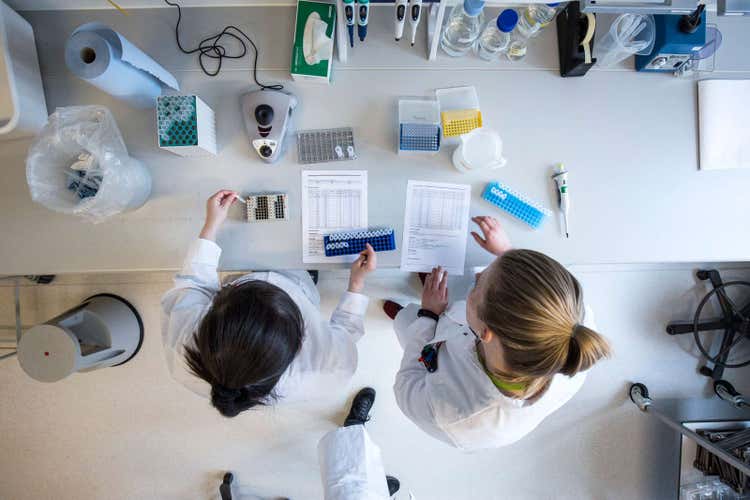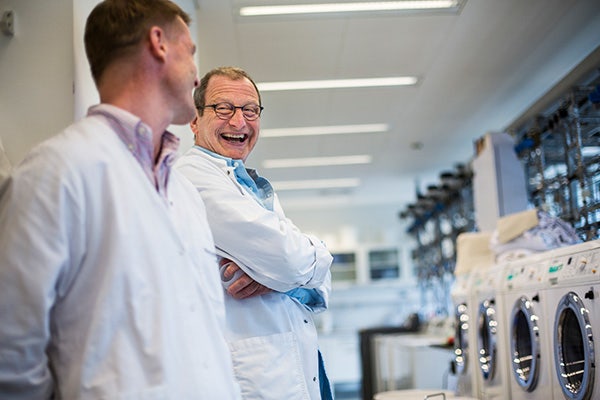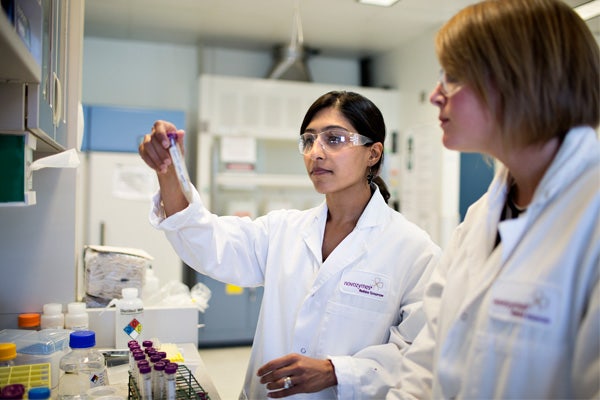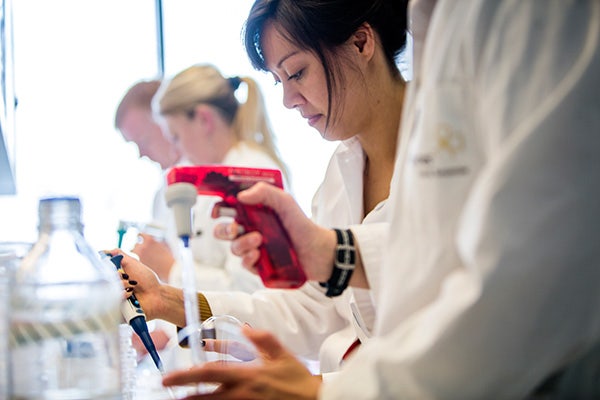Success Story
At Novonesis, an evolution in what it means to do science
How enterprise statistical enablement led to more reproducible research and bigger impact in the face of a changing planet


Challenge
The accelerating effects of climate change now require a fundamental shift toward scientific solutions that are both substantially more innovative – and arrive faster – than ever before. With creative, scientifically nimble leaders at its helm, Novonesis is answering this growing challenge by taking the difficult steps to become a fully statistically capable global organization.
Solution
Beyond just licensing new tools, Novonesis partnered with JMP® to empower scientists with the platform, training and support they needed to make effective use of statistical methods in their scientific practice. In just one example, a combination of the company’s high-level scientific expertise and a range of JMP functionalities enabled Novonesis to go from “zero to world leader” in biofuel yeast in the space of only a few years.
Results
Data scientist Michael Akerman explains that with enterprise data workflows consolidated in JMP, Novonesis is building products faster, more effectively and with higher quality. Moreover, he says, “the impact of Novonesis as a company can grow because we are using more effective methods to build the future of biotechnology.”
Recognized as one of Europe’s most innovative biotechnology companies, Denmark-based Novonesis is using cutting-edge science to address the challenges of a changing planet. The company’s ground-breaking work in enzyme and microbe development can now be found in everything from biodegradable detergents to plant-based meat alternatives.
“Novonesis has a very enthusiastic attitude when it comes to pushing the envelope in how biotechnology works,” says Lead Data Science Engineer Michael Akerman, who supports the company’s Agriculture & Industrial Biosolutions division. Though Akerman, who has a background in chemical engineering, began his career at Novonesis in biofuels experimentation, he now leads statistical implementation as part of a global focus within R&D for a more effective data strategy.
“I want science to be more data driven,” he says. “I think there's a lot of science that's done at a gut instinct level with older methods focused on a single factor at a time – or even on observation and intuition. And it’s just not sufficient, given the complexities of the world we live in.”
Beyond the limits of the physical lab
With its sustainability focus, Novonesis is better positioned than most to understand those complexities and the innovation needed to overcome them in service of a greener future. That same ethos has guided a deep analytics transformation that seeks to augment science with leading-edge data practices. Akerman explains that as the company sought to increase throughput in core areas like biofuel, leadership recognized how scientists were already pushing the limits of physical lab specifications and therefore required a new approach to maximize the value of their science.
“As the world gets more complex and we need to put out more products to meet more needs and to improve the world for the people who live in it, it gets harder and harder to [meet those needs while maintaining] quality standards,” Akerman explains.
“Every science leader in Novonesis really cares about doing science well. Almost all of them are former scientists themselves, and they’ve come up through the science organization. They want to see an evolution in what it means to do science.” For Novonesis, that evolution began with reimagining how scientists use data.


A transformative way of thinking about science
Akerman, like his sponsors in Novonesis’ leadership, strongly believes statistical approaches have the potential to transform scientific research for the better. Ultimately, he notes, better science means not only delivering value to the company, but also to people around the world. And the reasons are manifold:
- Statistics improves the quality of your science. “It is vitally important to science to be able to answer questions in a real way and avoid the biases that are so common in [traditional] experimentation,” Akerman says.
- Statistics can reduce costs. “It costs a lot to be wrong about product design,” he explains. “If you come out with something that your scientists are saying is definitely going to work – and then it turns out it doesn't work in the real world – that's a huge cost to the company.”
- Statistical enablement empowers scientists to use their domain knowledge at the highest level. Biological systems, Akerman says, are very complicated from an analytical standpoint. “We are almost always working in a space in R&D where we're not bound by the traditional optimization problem constraints that lend themselves to designs that are easy to pull out of a textbook.”
- Statistical tools facilitate better collaboration and promote outside-the-box thinking. “We have automated a lot of our laboratory, data and knowledge-sharing processes to capture the data in such a way that it is easy to share with the rest of the team. [Once scientists get used to a data environment,] they won’t go back to working in silos because now the whole group can work together on understanding what data means,” he says.
Ultimately, it was clear that Novonesis needed smarter ways to do experiments – and a more effective tool with which to analyze and individualize the results of those experiments, as well as communicate insights with stakeholders. “Early in my career, I sat with my colleagues to help use effective design of experiments and do more effective analysis and visualization. That’s part of pushing the envelope on how we do statistics and eventually, data science,” Akerman adds.
“Nowadays, with every scientist owning their own experiments and their own part of the scientific world, we really need to democratize statistics at Novonesis. We don't have a statistician waiting to analyze every experiment; rather, we rely on scientists to analyze their own work.”


Democratizing statistics through a strategic partnership
While many companies lean on a central statistics team to support scientists, Akerman explains that Novonesis took a different tact, approaching statistical enablement from the enterprise level. All scientists would be given the tools and training needed to apply statistical methods to their research.
“There's a lot of risk in having a separate statistics team that is handed data to analyze, and then just hands the report back [to the scientists],” he says. “Domain knowledge is absolutely vital.” By developing the statistical capacity of the entire R&D organization, scientists can then use statistics to augment their own biological expertise, ultimately gaining deeper product knowledge in the process.
Of course, two big challenges come along with the democratization of statistics. For one, Novonesis would have to provide scientists with training and resources that would enable them to execute statistical approaches correctly. Second, leadership would have to drive adoption from the top down, persuading scientists who might still be skeptical of a new methodology.
Key to overcoming both challenges, Akerman says, was Novonesis’ decision to partner with JMP®. A statistical discovery software and industry leader in design of experiments (DOE), JMP offered Novonesis wide-ranging statistical capability from basic data visualization to advanced functional data modeling – all packaged in a user-friendly platform that could be run without code on any laptop.
“JMP is one of the few tools I feel like I can trust every scientist to use confidently for scientific insight generation. Every analysis has sensible defaults that are explained well – that tell you what's going on in the platform,” Akerman says. “The visualization tools in JMP of course make it very easy to look at the data from different angles, even when we've got lots of different variables. I've never seen anyone come to JMP and not immediately love Graph Builder… And all the documentation is easily available for any analysis or visualization [users] might want to do.”
More than just a software, in JMP Akerman saw the potential for a partnership that could help Novonesis drive analytics adoption at scale. JMP, he says, has worked strategically with Novonesis to assess areas ripe for improvements in data workflows – and support the organization with training, resources and access to JMP experts.
With the culture at Novonesis very much on board with statistical enablement, the organization began its implementation with upskilling. “All of our scientists are interested in improvement – they want to do [their scientific work] well and improve on their methodologies,” Akerman says. “But even though everyone jumped in feet first, they were coming from a place where the educational system doesn't necessarily emphasize statistics to the degree I'd love to see for scientists.”
Fortunately, JMP was a prime partner to support the rollout of new training on a broad scale thanks to resources like Statistical Thinking for Industrial Problem Solving (STIPS) – a free online course from JMP – and access to an active team of JMP subject matter experts. Says Akerman: “The challenge at Novonesis was getting scientists up to speed in statistics and getting them access to the resources they needed to learn those new skills, which is why I think STIPS is so effective. STIPS provides a really nice on-ramp to improving your skills in a very concrete way around what you're actually doing.”
From zero to world leader
Significant wins only further bolstered demand for statistical training and hastened the pace at which data-driven science spread. Among these wins, perhaps the most dramatic success came in biofuel yeast. A relative latecomer to the field of enzyme-expressing yeasts, Novonesis sought to leverage statistical transformation to accelerate the pace of R&D.
At the division’s nascent stages, Akerman’s team had been called upon to develop a system that would make data sharing frictionless, communication effortless and ongoing work seamless. “The scientists spent a lot of energy, focus and effort working with my team, working in JMP, and understanding data practices to make their data more effective than it would have been otherwise,” he explains. A key goal was to streamline entire data workflows with relatively minimal scripting. This automation not only added a layer of reproducibility, but it also hastened the pace of experimentation and made the effort more collaborative.
The resulting system, MissionControl for Biofuel, features a JMP table that uses event handlers to pull assay data from strain construction and design through testing in application research labs and scale-up. These data streams are then collected through a combination of JMP and Python scripts and deployed in a format that allows scientists to very easily traverse and interrogate the data regardless of complexity level. For example, MissionControl’s dynamic interface panels show genetic lineage, measured genotype, manufacturability summary and experiment history, enabling scientists to bypass traditional data access challenges. The system, Akerman says, provides a rich user interface experience for data exploration and building layers of product understanding not previously possible.
“[MissionControl] has been a game changer for how yeast science is done – a game changer in a sequence of many game changers – ultimately allowing our team to go from zero to world leader in biofuel yeast in just a couple of years,” Akerman says.

Scaling up with JMP automation delivers exponential value
With scientists individually empowered to utilize statistical methods – augmented by their access to standardized automated dashboards – Novonesis’ bet on the democratization of statistics has paid off many times over. Even a small amount of automation, Akerman explains, has been critical in scaling up the benefits of putting a statistical tool into the hands of scientists.
“All the people doing analysis are now also trying to get faster and faster at it, trying to automate it, trying to reuse analysis that they've done previously,” he says. “That’s why my team is now focused on building tooling to help scientists work with data more efficiently and effectively [through automation].” The JMP scripting language (JSL), he adds, makes it easy to package a particular methodology and deploy it to multiple scientists who can then reproduce the same method accordingly. Reproducibility, he says, builds confidence in the accuracy of experimental results.
Novonesis has further encouraged the building and sharing of JMP add-ins by developing an internal tool to facilitate shared use and versioning. Users can now save a JSL script out of any platform in JMP and upload it to the company’s intranet where it is available within seconds to users across the company. Furthermore, it updates automatically. (For more on this, watch Akerman’s 2021 Discovery Summit talk, As Easy as Uploading a Photo: Building, Sharing, and Updating Add-ins Automatically.)
Building the future of biotechnology
Reflecting on these and other successes, Akerman is clearly energized by the prospect of meaningful innovation not just in Novonesis’ science but in the broader scientific process. “It excites me to be able to improve lives materially, both in the sense of my colleagues who are doing science – making their science more effective and easier to do – and in making their impact on the world greater by making their data resonate through time in a more meaningful way beyond just a single experiment,” he says.
“Whether we’re working on enzyme or microbial products, if we can build things faster, more effectively and with higher quality, that increases impact. [With enterprise analytics,] the impact of Novonesis as a company can grow because we are using more effective methods to build the future of biotechnology.”